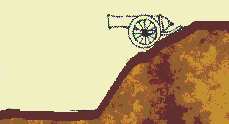|
The motion of objects The core to Aristotle's philosophy is that nature is understandable, explainable and predictable. However, he developed a holistic view of nature (versus the Newtonian mechanical view) Aristotle constructed his view of the Universe based on a intuitive felling of holistic harmony. Central to this philosophy was the concept of teleology or final causation. He supposed that individual objects (e.g. a falling rock) and systems (e.g. the motion of the planets) subordinate their behavior to an overall plan or destiny. Objects, being solid like earth, would tend to clump together with other solids (earth), so objects tend to fall to earth, their natural place. Thus, falling is a natural motion. Galileo showed that objects fall with the same speed regardless of their mass. The fact that a feather falls slowly than a steel ball is due to amount of air resistance that a feather experiences (alot) versus the steel ball (very little). |
|
Why do things STAY in motion (Projectile Motion)
Think of a spear being thrown. At first, it is not in motion, but then the thrower's arm
provides an impetus which accelerates it (our vocabulary, not Aristotle's). But then, what
keeps it going after it leaves the thrower's hand? It should fall to earth immediately
since there's nothing obvious pushing it! Elaborate explanations were hatched; for
example, it was proposed that the arrow creating a vacuum behind it into which air
rushed and applied a force to the back of the arrow! Aristotle believed if stopped
pushing something, it stopped moving. Now gravity is an external force (pushing) that
causes a stone to fall (move), but even Galileo did not realize that. Before Newton,
the falling of a stone was considered natural motion that did not require any
outside help. See applet
here

| 
|
projectiles moved | "really" move |

